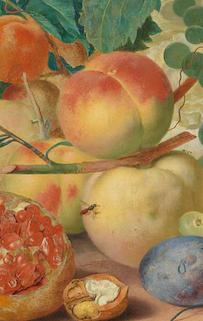
MAGAZINE The Truly Beautiful Woman page 6 Son, Give Me Thy Heart page 11 Political Demographics and Identity Politics page 23 04 Vol 2 No 1 peace issue metanoia
CONTRIBUTORS
EDITOR-IN-CHIEF
Isabel Cumbelich
CONTENT DIRECTOR
Zoë Grimm
CREATIVE DIRECTOR
Maghee Fleischer
CONTENT ASSISTANT
Alex Dean
ADMIN ASSISTANT
Mark Taylor
DESIGNERS
Amalie Garnard
Anna Enyart
Isabel Cumbelich
Gwyneth Sawicki
ADVISORY BOARD
Kathleen Sullivan, PhD
Niall O’Donnell
Joseph Brutto, PhD
Daniel McInerny, PhD
Hugh O’Donnell, PhD

LETTER FROM THE EDITOR
Dear Reader,
MISSION STATEMENT:
Metanoia is a student magazine that showcases the height of Christendom College excellence in the areas of journalism, art, and design. It is meant to inspire thoughtful conversation among the student body and the broader Christendom community. Metanoia articles address issues concerning society, our immediate surroundings, and ourselves. Metanoia allows promising students the opportunity to develop their talents so that they can use contemporary media to “Restore All Things in Christ.”
Welcome to Metanoia Magazine, volume two, issue one: The Peace Issue. Students at Christendom give their hearts to the community. They spend late nights planning S.A.C. events, weekends traveling for sports games, and hours in the library writing articles for Metanoia. As a senior, you begin more and more to realize the preciousness of time—the need to slow down and identify the most important things, so that you can give yourself more fully to them.
The reality is, God hasn’t created us to be perpetually exhausted, although most students will admit exhaustion is status quo in college. Although our American culture might teach otherwise, being busy for it’s own sake is not a virtue. So, I suppose what I would advocate for is this: minimize what you do so that you may truly possess a quietness of soul and have the peace to follow His plan.
In Christ,
Isabel Cumbelich Editor-in-Chief
— 2 —
@JulieWellsPhotography
Metanoia Magazine SELF beyond coffee the truly beautiful woman SURROUNDINGS son, give me thy heart dolce far niente: the sweetness of doing nothing SOCIETY our culture of nothingness political demographics & identity politics 4 6 11 23 19 IN SIDE THISISSUE 16 @JulieWellsPhotography — 3 —
BEYOND COFF EE
by ELIZABETH KUSS ’23

Whatif you could feel energized and enthused all day, without a chemical stimulant? What if you could sit down and focus on a difficult task without requiring a latte or a cup of medium roasted coffee? Coffee is a fundamental ritual of American adulthood. A toasty cup of coffee with a generous pour of Caramel International Delight is a strong incentive to sit down to an unappealing pile of homework, whether you are running on three hours of sleep or not. So why give up the coffee habit? Whatever gets the homework done, right? I won’t bother to mention that, like all mind-altering drugs, caffeine gradually loses its desired effect when habitually consumed. I also won’t bother to discuss how caffeine junkies may experience side effects such as poorer sleep quality, muscle twitching, tingling sensations in your
Self — 4 —
hands and legs (don’t ask me how I know), and so forth. Consider this instead. What if your coffee habit is barring you from developing those other two sources of energy: true enthusiasm for intellectual work itself, and sustained focus through mental discipline? If you require coffee before you sit down to work, are you really studying with enthusiasm for the subject at hand? Once a coffee habit sets in, and the triple-shot mocha with whip becomes your ritual to initiate a study session, your enthusiasm for an intriguing history topic may become a secondary motivation to start your essay. Let‘s face it: if an outside source of chemical stimulation controls your energy, pure intellectual curiosity will not be sufficient to keep you motivated and studying. If you were never enthusiastic about a particular homework assignment to begin with, you must rely on will power to focus on a dull task. Focus is a mental muscle you develop through self-discipline. Block out all distractions when studying. Look up web articles on focus exercises if you really want to improve your focus. 1 No amount of coffee can




magically grant mental discipline. By habitually pouring yourself another cup to regain your focus, you’re relying on coffee instead of selfdiscipline to keep you working. I’m not here to condemn caffeine. If you slept only three hours last night, a cup of coffee is better than a nap in Latin class. Coffee wakes up your brain when you can’t afford to fall asleep. But true enthusiasm and focus come from within, not from a cup of coffee. So, consider cutting back on your caffeine consumption if you desire genuine energy instead of drug-induced energy. You’ll also need sleep to make sure you don’t relapse into your old four-cups-aday habit. All-nighters and late hangouts with friends are part of life, but consider hitting six to eight hours of sleep at least several nights a week (consider committing to sleep at least seven hours Monday through Wednesday nights, for example). If intellectual motivation and mental-discipline are important to you, backing away from a coffeecentric lifestyle is worth the effort.

1. My favorite source for focus exercises: www.brainscape.com/academy/focus-exercises-build-attention-span/
Metanoia Magazine
— 5 —
the TRULY BEAUTIFUL WO



Self
M
— 6 —
A N




asked a handful of professors what they thought the most important attributes of the truly beautiful woman are, and they all agreed that the true beauty radiates from within. It is an internal beauty that overpowers externals.
While that is lovely to hear and touches upon the spiritual side of man, it is hard to implement as a young woman simply seek ing truth. Though not all encompassing of the beautiful wom an, focusing on a few more concrete qualities makes an abstract thought more tangible. There are four specific attributes that a woman of real beauty exemplifies: joy, peace, love, and life.
How does joy manifest itself in one’s life? Psalm 95:1–2 says, “Oh come, let us sing to the Lord; let us make a joyful noise to the rock of our salvation! Let us come into his presence with thanksgiving; let us make a joyful noise to him with songs of praise!” And 1 Chronicles 16:34 says, “Give thanks to the Lord, for he is good; for his steadfast love endures forever!” Joy is found primarily in recognizing the goodness of God. We are told to come into His presence and to rejoice in His goodness.
On an everyday level, this can be done by visits to the Blessed Sacrament, reception of the Eucharist, or intentional spiritual communions. In order to practice this recognition of the goodness of God at all times, not only during visits to the chapel, one must see Christ in others, providing a constant joy. Look at those around you, your friends, family, strangers, and even enemies, and see the goodness of God in them. Rejoice in that goodness! Look at others and thank God for the goodness He has placed in them. Do the same for all situations in life. To foster joy, one must seek out goodness and rejoice in it. This is how joy may be maintained even through sorrowful times. Despair is opposed to


Metanoia Magazine
— 7 —




joy, but the ability to rejoice in the good is still present during times of sorrow. Women have a unique ability to see the good in others. The truly beautiful woman looks especially at internal qualities and can rejoice in the gifts God
Peace often seems like something for other people and not for oneself. While others are content, I will feel anxious all of the time and peace is out of reach. This is a lie. The devil especially likes to whisper it in the ears of women. Philippians 4:6–7 says, “Have no anxiety about anything, but in everything by prayer and supplication with thanksgiving let your requests be made known to God. And the peace of God, which passes all understanding, will keep your hearts and your minds in Christ Jesus.” There is a clear connection between peace and joy, for
“Even if we cannot control when anxiety will strike, we must fight against it immediately or else the devil may find a foothold. Turn whatever causes anxiety over to God immediately."

not only are we told to bring our petitions to God, letting them rest in His care, but we are told to give thanks. Rejoice, for Our Father takes all of our concerns and lifts the burdens from our shoulders. In order to truly be at peace, we must trust in God’s plan and allow ourselves to relax into His loving arms. Anxiety is the devil’s tool. Even if we cannot control when anxiety will strike, we must fight against it immediately or else the devil may find a foothold. Turn whatever causes anxiety over to God immediately. Let go of that attachment and peace will be victorious. As a practical tip for practicing peace, if anxiety or stress starts to overwhelm you, first ask Our Lady to hold your hand and push the evil one away, and then do something that calms you and refocuses your mind and heart. It can be as simple as rearranging a bulletin board. When everything seems crazy and out of control, turn to that little task and enjoy putting intentional order into it. It calms the mind and heart, and thus puts order into oneself. The truly beautiful woman has an unshakable peace about her, one that orders her mind and heart.
The last two attributes, love and life, are so closely connected in the woman that they can really be treated as one: gift. By her very nature, woman is
Self — 8 —
designed to give. John 15:12–13 says, “This is my commandment, that you love one another as I have loved you. Greater love has no man than this, that a man lay down his life for his friends.” The truest form of love involves sacrifice, that of giving one’s whole life for another. Women naturally love in a sacrificial way because of how God has designed us: as mothers, made to give and nurture life. Therefore, women love best by giving life and live best by nurturing love. Nurturing life does not only encompass the literal bearing of a child, though obviously that is a climactic moment of a woman’s life-giving nature, but it can be found in the way a woman fosters community and friendships. This can be done through her personality, her gift for guiding conversation, or even through the way she intentionally arranges spaces so that friends may better interact and connect. Notice, many women at Christendom take the time to arrange their dorm rooms to welcome others in, to get comfortable, and to chat the night away. This is a part of nurturing life, the good life. By embracing her motherly nature, the truly beautiful woman impacts the world around her by radiating the beauty of the Imago Dei
Let us again ask: what are the most important qualities of the truly beautiful woman? She radiates a sense of joy, peace, and love, and gives to the lives of those around her. All women are called to rejoice in the good, to bring order into their own lives and those of others through peace, and to love and nurture life through



sharing their gifts. God has gifted woman with natural inclinations to lead her to perfection. By embracing her unique gifts, and accepting her calling, every woman can be truly beautiful.



Metanoia Magazine — 9 —

Surroundings — 10 —
Son, GIVE ME THY HEART
by JAKE STEVENS ’23
I am with you always, to the end of the age.
Perhaps when we see someone living as a friend of God, we are inspired to change and emulate the virtue that they express so well. Someone I think of often for inspiration is Archbishop Fulton J. Sheen. Why this man in particular? Bishop Sheen, with his great sense of humor and keen intellect, was popular in 1950s America, among Catholics and non-Catholics alike. What did he credit for his success in preaching the Gospel to millions of souls and producing great fruit? As he himself said, it was not what he, the bishop, did. Instead, this holy man credited his daily devotion to the Eucharistic King as the reason for any of his success. From the day of his ordination to the priesthood up unto the last day of his life, the Bishop spent one hour a day in the Presence of the Blessed Sacrament. Not a single day was missed.

Indeed, even Bishop Sheen’s death exemplifies his spirituality: devotion to Jesus and Mary. He died in the Presence of Christ, on the Feast of the Immaculate Conception, in 1979. How beautiful and fitting for one so devoted to the Son of Mary, present to us under the appearance of bread and wine. While this is one wonderful example of many, Bishop Sheen’s prayer life shows the beauty, simplicity, and importance of personally being with Christ, who is hidden among us. I want to emphasize, as a Christendom student, the importance of devotion to the Blessed Sacrament, of fostering a personal relationship with our Lord, present to us in the Tabernacle always. Here are the words of the bishop himself: “The purpose of the Holy Hour is to encourage deep personal encounter with Christ. The holy and glorious God is constantly inviting us to come to Him, to
Archbishop Fulton J Sheen artwork
Metanoia Magazine — 11 —
byJosephCole ’23


hold converse with Him, to ask for such things as we need and to experience what a blessing there is in fellowship with Him.”1
Not everyone is called to daily Holy Hours. Nevertheless we, as Christians, are all called to a personal encounter with Christ. How can we, as Christendom students, busy with our studies, extracurriculars, and the other various duties in our current vocation and state of life, truly foster our relationship with God through devotion to Him in the Blessed Sacrament?
To use another saint’s example, when St. John Henry Newman was ordained a cardinal by Pope Leo XIII, the motto he chose was thus: cor ad cor loquitur. Heart speaks to heart. A saint best known for his dedication to faithful Catholic education chose a deeply personal expression as his motto. I think there is much we can glean from this. As Christians we are members of the Mystical Body of Christ. Through sanctifying grace, we enjoy a personal relationship with God. This is a pure gift on God’s part which we, quite frankly, do not deserve. However, the nature of this relationship, unworthy of it though we are, is not one-sided. We, as free agents aided by the grace of God, can contribute and be present in our relationship with God.
As for applying this to our time here, we have a lot going for us: Mass is available every day at convenient times. There is adoration Monday through Friday. All of this is great, but, as with many things
1. From Bishop Sheen’s autobiography A Treasure in Clay
Surroundings — 12 —
at Christendom, they can be taken for granted, or we can get overwhelmed by the amount of things we have to attend to on campus. It may be hard to carve out a specific time for prayer. What shall we do? I think the answer lies in the motto of Cardinal Newman: Heart speaks to heart. Personal time with the Lord, outside of official, scheduled times, is extremely valuable.
Let’s get even more practical. How many times a day do you walk past the chapel? Every time we walk down the Dip, for example. We can all imagine in our minds the walk from the Commons to the Library. “I have to go to class.” “I have work in the kitchen.” “Time to write a paper.” “The midterm is coming up.” But whether we think about it or not, He is always there. The red candle is always burning, even when we are thinking about something else. Maybe we have a little bit of time between classes to stop in, genuflect, and walk out. Maybe it’s night, and you’re walking from one side of campus to the other. You pass Him. We greet our friends when we pass them on the way. It doesn’t have to be hours of prayer. Maybe just a genuflection. Less than a minute. But it’s a visible, personal sign of the love we have for Him. He died on the Cross and His Heart was pierced for us. Maybe this is what we need on campus. He wants us to fulfill His wish: Son, give me thy heart.

“His heart was pierced for


Metanoia Magazine — 13 —
Dolce Far Niente THE SWEETNESS OF DOING NOTHING
by MAESA VICENTE ’23

I’m sure some of you have heard the overplayed voiceover on Instagram reels: “We call it the dolce far niente ... the sweetness of doing nothing.” For me, this voiceover could frankly not be played enough. When I look back on my Rome semester of the last three months, I can truly say that these three words encompass a great deal of what I learned and experienced.
Living in one of the most cosmopolitan cities in the world, with hundreds of tourists pouring in and out every single day, I was surprised to find myself overwhelmed by a sense of peace and security that I have never felt elsewhere. Instead of being rushed into a typical bustling city life, I was forced to slow down. Although I could talk on and on about the beauty of the dolce vita, I will focus on three aspects of it.
Society
Surroundings
— 14 —

“Doing nothing opened my eyes to see that the world is full of art...”

1 2
Daily Walks in Rome
Rome is a small town. With regular use of Rome’s public transportation system, one can easily become familiar with the city and its clear landmarks. There were several times where I would run into the same person I had seen hours before, or repeatedly pass that same cafe or hidden church or vibrantly green street corner. There, I actually took the time to explore the place I was living in, to know it, and to love it.
The Quality of Mealtime
An article by Insider writes that “there are many differences between Italian and American diets, in the way that we eat, shop for meals, and even the way we think about food.”1 Italians shop at small markets with local and fresh in-season products. In the processed food culture that is prevalent in America, dieting just cancels out food products whose original form is necessary for health. Italians don’t have guilty pleasure foods, just pleasure foods, because all of their food is fresh and contains all the nutrients that our bodies need. Italians also set aside large chunks of their day to prepare a meal and calmly eat it. They prioritize quality mealtime and conversation over work. Living in this way makes work feel less stressful because one is well-rested and because there are healthy boundaries between work and home.

1. https://www.insider.com/biggest-differences-italian-american-diets-food-2018-5#italiansgenerally-shop-at-small-markets-rather-than-bigger-grocery-stores-1
Metanoia Magazine
— 15 —
3
Nothing is Something
In between sightseeing and tours, there was always plenty of time to wander around and do nothing. At first I would get annoyed when people walked slowly in front of me or the cobblestone made it tricky for me to stay at a steady pace. However, I came to the shocking realization that there was in fact no reason to hurry. Most of the time I truly had nowhere to go. Walking along the Tiber or past the Castel Sant’Angelo I would come upon a harpist playing beautiful melodies with birds and children stopping to watch. Doing nothing gave me the best conversations with people from all over the world, Prosecco at bookshops, and artists sketching the sunset. Doing nothing opened my eyes to see that the world is full of art. In those little moments that go by unnoticed. In the sweetness of doing nothing.


Surroundings — 16 —

“...in those little moments that go by unnoticed. In the sweetness of doing nothing."
Metanoia Magazine — 17 —

Society — 18 —
Our Culture of NOTHINGNESS
 by MARK TAYLOR ’24
by MARK TAYLOR ’24
This summer I had an internship in DC. Since I live in northern Virginia, I took the Metro up into the city every morning and came back every evening. During my two months or so of commuting, I noticed a few interesting patterns. When someone gets on the Metro car, he goes to his seat and sits down. Then most people immediately take out their phones and are immediately sucked into a virtual world. Others will take out a book and read that. Others choose to stare into the abyss, listening to something with their earbuds. Every day, the body language sent the same clear message: “Leave me alone.” No one was present to their surroundings, each escaping to some other world they were more comfortable with. I was no exception, huddling against the window to pray the Divine Office or listen to a podcast. It felt like there was an unbreakable barrier between myself and those around me.
When I arrived in DC, the isolation continued. Masses of people hurriedly walked by at Union Station, trying to avoid each other as much as possible to get to work on time. There were hordes of homeless, some hunched in a corner, others yelling angrily at nothing in particular. The commuter and social pariah, the congressional staffer and drug addict, two distinct classes of people, were united in their isolation from others. It was a unity of disunity.
There were a few instances that broke the rule of isolation on the Metro, a few shining moments when people would actually talk to one another. These people were almost exclusively

Metanoia Magazine — 19 —

members of the military or families talking among their respective groups. Military personnel working at the Pentagon would strike up a conversation about their jobs, the news, or just life in general. Likewise, families taking a day trip into DC went chatting all the way.
What these two groups have in common is a shared culture. Both the soldiers and the families shared a culture they could easily recognize in each other and relate to. They were able to break past the individual to something held in common, allowing for conversation to occur. I noticed something similar with the taxi drivers outside Union Station. They were always speaking to each other in some African dialect, either heartily agreeing on some issue or on the verge of violence. This shared ethnic culture was what allowed them to converse and interact, even if it was sometimes in an aggressive way.
For the rest of us, there was nothing in common. Or rather, we were so interested in in our own personal
Societ — 20 —

lives, our own social media, and our own podcasts that the isolation caused by them was the only thing we held in common. The outer monotony was maintained day by day, each individual isolated in this strange unity of disunity.
But what causes this culture to exist? Is it caused by the overwhelming presence of social media in society? Is it relativism or some other philosophical or moral problem? Is it the banishment of God in the modern age? While these are all likely causes, I believe the immediate source for our lack of culture is that modern man is terrified of the real world. Wherever he goes, man tries to hide from the world around him. He uses visual or audio media to distract himself from the reality around him. Technologies that place one deep inside a virtual world, such as the recently created “Metaverse,” are becoming increasingly popular. People are attempting to separate themselves from reality as much as possible. This avoidance of the real world is leading to deep, societal isolation.
This grim reality is a call to action for us, even if the darkness of our culture seems overwhelming. Our faith demands that we evangelize, and there is no better way to do so than to fight against the fearful isolation so many are in today. Just a smile can do so much in this regard. A smile has great power to encourage and comfort those around us. It is the first step in drawing others out of isolation and into the real world. Then, a new culture of light may be created.


Modern man is terrified of the real world.

Metanoia Magazine
— 21 —

— 22 — Society

& Political Demographics
IDENTITY
POLITICS
by ANTHONY ACCURSO ’24
In any strategic situation, it is important to identify where a battle is to take place and assess its geographic terrain.
Metanoia Magazine Metanoia Magazine — 23 —
An illustration of this can be seen in Michael Shaara’s novel The Killer Angels and its 1993 film adaptation Gettysburg in which, prior to the start of the battle, General John Buford of the First US Cavalry Division assessed the terrain surrounding Gettysburg and took action based on the situation at hand, dismounting his cavalry and using them as a stalling force. Buford’s tactics directly contributed to why Gettysburg ended the way it did. The sphere of strategic politics is no different, only instead of assessing geographic terrain, one must assess the demographic terrain.
Since the Truman administration, the Democratic Party has generally been considered the party of the working class and minorities. Meanwhile the Republican Party has been associated with older white conservatives. However, the political landscape wasn’t always this way.
Black Americans are a particularly interesting example of fluctuating political demographics. After the War Between the States, the Black community typically aligned itself with the party of Lincoln. After all, they had just been freed from the bonds of slavery by Lincoln and the Republican Congress. This was the case until a major shift occurred in the 1930s. With the election of Franklin D. Roosevelt in the midst of the Great Depression, the Black community began to vote for the party of Jackson rather than that of Lincoln due to FDR’s “New Deal” poli-
cies. Since then, no shift quite as dramatic has occurred and the Black community has been mostly Blue since then. Consequently, we’ve gotten comments claiming things like an individual “ain’t black” if he’s had trouble voting for the expected candidate.
The voting histories of various minorities are all different, but each demonstrates the same point: political demographics can and do shift. This applies to racial minorities and identity groups as much as it does any type of demographic. However, the massive shifts happening today are particularly noteworthy. For example, over the last three cycles, the Democratic presidential candidate has won an average 67.3% of the Latino vote. Back in May of 2021, President Biden’s poll numbers for Latinos were right around 55%, but in May of this year, his approval rating plunged to a staggering 26%. This turnaround is a crippling blow to the party’s base. Not only that, but even in dense Latino areas that went for Biden in 2020, there were massive rightward shifts in the margins, meaning that Democrats didn’t win so easily in these former strongholds.
And it doesn’t end with Latinos. In 2020, Biden carried just under 80% of the Black vote, the lowest margin since 1996 for any Democratic presidential candidate. While this is the weakest showing in a quarter-century, a 3:1 margin is still a 3:1 margin.
Society
Democraticpartyappearstobeslowlybecomingthepartyofwhite, college-educated,youngadults,ademographicwhichhascometobe knownas“snowflakes.”Meanwhile,theGOPbecomesmoreandmore diverseeveryyear.ButastheDemocratPartycontinuestocatertothese left-leaningindividuals,theRepublicanPartyhasitsownproblemof becomingincreasinglyreactionary.
However, recent polling puts Biden’s support among black adults at a startling 67%. This drastic decrease spells trouble not only for Biden, but for the Democratic Party at large.
So, why are these shifts happening? The increasing progressive policies of the left are repelling former members of their base, while simultaneously attracting a whole new demographic. The Democratic Party appears to be slowly becoming the party of white, college-educated, young adults, a demographic which has come to be known as “snowflakes.” Meanwhile, the GOP becomes more and more diverse every year. But as the Democrat Party continues to cater to these left-leaning individuals, the Republican Party has its own problem of becoming increasingly reactionary. This has led to the development of a “cult-of-personality” problem within both parties. This phenomenon can be traced back to during the Obama administration, when the 44th president leveraged his unique cultural popularity to take a much further-left stance during the 2012 election than he otherwise could have, making “identity politics” a major focus of the campaign
(identity politics being the formation of political alliances on the grounds of race, sexual orientation, etc.). In turn, this led to Obama becoming a godlike figure within the party. The right then reacted by putting its own spin on this way of doing politics in 2016 with the birth of the MAGA movement and the bombastic personality of Obama’s successor.
As someone who has had personal experience in local politics and grassroots organizing since as far back as I can remember, this shift from what I like to call “Tea Party conservatism” to “MAGA conservatism” was stark. I remember going to my legislative district meetings as a precinct committeeman in January and summer of 2021, only to find that the district had been overrun by new MAGA conservatives, who knew nothing about issues or principles, let alone what America was founded on. These newly active individuals came and supported only President Trump, as if he could do no wrong. My family has attended these meetings for over a decade and firmly supported Trump’s policies. But even despite our agreement on most issues, these newcomers treated us with blatant hostility, because
Metanoia Magazine
we didn’t view Trump as infallible. On one occasion, we were told by a new member that “this is the party of Trump now, so you better get on the train or leave.”
This type of “cult of personality politics” is dangerous, not only for the GOP, but for the country as a whole. Today’s politics are degenerating into a popularity contest. While there are exceptions to this rule—Glenn Youngkin’s 2021 campaign for governor comes to mind—they are becoming increasingly rare. The personality of politicians should not be the sole focus of the base; rather, it ought to be ideals and principles that the candidate represents. If it continues down this path, I can only feel the same pain that General Buford felt in Gettysburg as he surveyed the terrain, recognizing what would happen if he did not act. “It’s as if I can actually see the blue troops in one long bloody moment. Go-
ing up the long slope to the stony top. As if it were already done, already a memory. As if tomorrow's already happened and there’s nothing you can do about it.” But that doesn’t mean that this is inevitable. Just as Buford took action to change the course of the battle and therefore history, we too have an opportunity. An opportunity to move away from these political tactics and move toward a more perfect union.


Society
-Jordan B. Peterson
“It takes careful observation, and education, and reflection, and communication with others, just to scratch the surface of your beliefs.”



Vol 2 No 1
SUBSCRIBE








































 by MARK TAYLOR ’24
by MARK TAYLOR ’24










